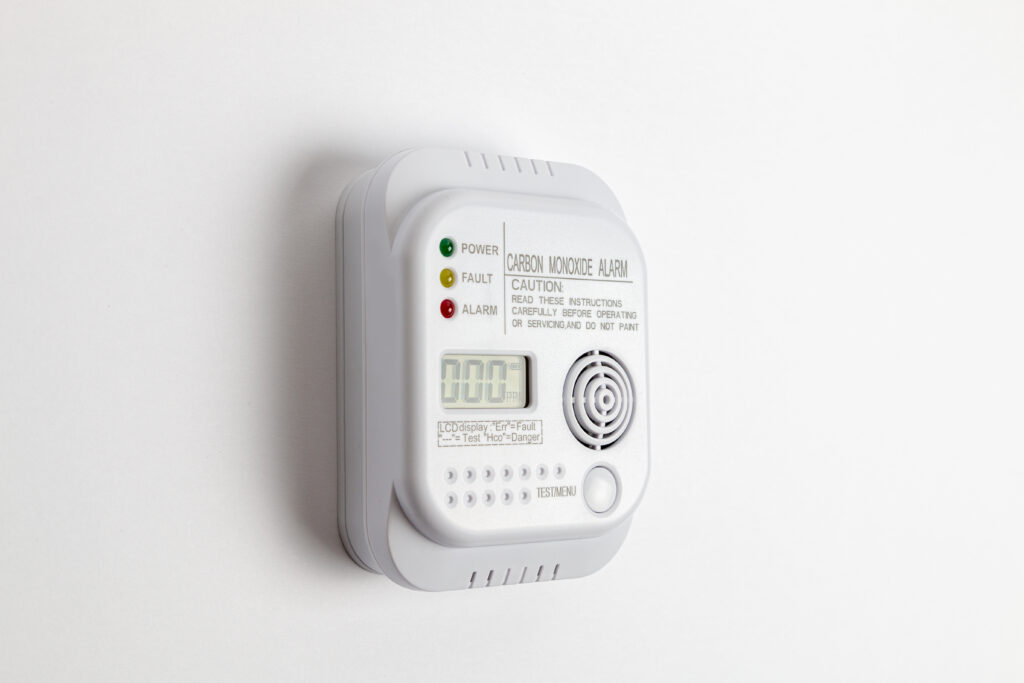The importance of carbon monoxide (CO) alarms in UK homes, particularly rental properties, cannot be overstated. These devices are crucial for detecting carbon monoxide, a colourless, odourless and potentially deadly gas. This blog article covers the essentials of CO alarms, including landlord responsibilities under UK law, alarm functionality, dangers of CO, and testing procedures.

The Dangers of Carbon Monoxide
CO prevents blood from carrying oxygen, leading to tissue damage or death. Symptoms of CO poisoning include flu-like symptoms at mild levels, and collapse or coma at higher concentrations.
Understanding Carbon Monoxide Alarms
Carbon monoxide alarms are designed to detect carbon monoxide gas. Since CO is produced by incomplete burning of carbon-based fuels like gas, oil, wood, and coal, these alarms are vital in homes with any fuel-burning appliances, regardless of their age.
The Critical Need for Carbon Monoxide Alarms
The silent and invisible nature of carbon monoxide makes it particularly dangerous. It can cause symptoms like headaches, dizziness, and nausea, and in high concentrations, can lead to fatal poisoning. Alarms provide an early warning, helping identify these risks.
Legal Responsibilities of UK Landlords
Under the Smoke and Carbon Monoxide Alarm (Amendment) Regulations 2022, UK landlords must:
- Install at least one smoke alarm on each storey used as living accommodation.
- Equip a CO alarm in rooms with any fixed combustion appliance, excluding gas cookers.
- Repair or replace any faulty alarms during tenancy. Failure to comply can result in a £5,000 fine.
How Carbon Monoxide Alarms Work
These alarms use different technologies to detect CO gas in the air, such as biomimetic sensors, metal oxide semiconductors, and electrochemical sensors. The type of alarm (mains powered or battery powered) depends on the building’s and tenants’ needs, with alarms compliant with British Standards BS 50291 being recommended.
Placement and Maintenance of Alarms
- Smoke Alarms: Should be installed on every storey, typically on ceilings in circulation spaces like halls or landings.
- Carbon Monoxide Alarms: Should be placed in rooms with fixed combustion appliances, positioned at head height, near the potential CO source.
- Testing and Batteries: Tenants should test alarms regularly, with landlords responsible for repairs or replacements of faulty alarms. Landlords are advised to provide instructions for testing.
Special Considerations
- For People with Disabilities: Alarms with vibration or flashing lights may be necessary for residents who are deaf or hard of hearing.
- Installation Requirements: Landlords must ensure alarms are properly installed and working at the start of each new tenancy.
Applicability of Regulations
These regulations apply to private and social rented homes, with certain exemptions like shared accommodation with landlords, long leases, and student halls of residence.
Enforcement and Compliance
Local housing authorities enforce these regulations. Landlords are expected to take remedial action promptly if non-compliant and can appeal against penalty charge notices. In case of difficulty gaining access to a property for alarm installation or repair, landlords must demonstrate reasonable efforts to comply.
Carbon monoxide alarms are a critical safety feature for UK homes. Landlords must comply with legal requirements to protect tenants from the dangers of CO. Regular testing and maintenance of these alarms are crucial for their effectiveness.
If you’re a landlord, it’s crucial to ensure that your properties are equipped with functioning carbon monoxide alarms. Contact us at Nicholas Humphreys for guidance on installation, maintenance, and compliance with regulations, ensuring your tenants’ safety and your peace of mind.





